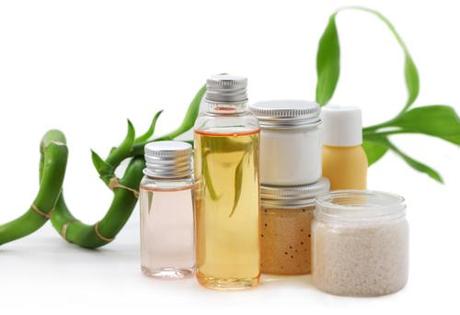
Paraben-free. Free from parabens. Formulated without parabens.
Besides being seen as hype by skeptics, a marketing shtick and highly controversial, what’s it really telling us? What do we do?
The rising concern with using parabens and other synthetic preservatives such as DMDM Hydantoin and Quaternium-15 (both of which release formaldehyde) has made beauty companies scramble to find more “natural”, safer preservatives to use in their place. Phenoxyethanol, another preservative quickly gaining traction, has also been under scrutiny with purists and activists for reports of it possibly disrupting endocrines and being a skin irritant. Urea and EDTA have also made headlines.
The Environmental Working Group currently runs a campaign educating the public about the risks on using cosmetics and personal care products preserved with parabens and other synthetic preservatives.
Some studies show some parabens can partially mimic estrogen, and have been found in breast cancer tumors in women. (Note that I’m NOT saying they’re the cause of them, though. I wouldn’t believe reports stating such a bold claim, either.) Though, it makes you wonder – if parabens are this dangerous, why haven’t they been pulled from shelves yet? This information has been viral for many months, hence the sudden surge of labels claiming paraben-free formulations.
For those “in the know”, this prompts them to read the label for the alternative preservative being used. Keep in mind that in most products, they’re listed near the end of the ingredients as they should take up 0.75 – 2% of a particular product. This amount is usually enough to preserve them from 6 – 30 months, depending on what’s used. Beauty products made with water or water-based products like aloe vera leaf juice and distillates require a preservative.
Here are a few of the alternate preservatives you may find on the labels of ‘natural’, organic and greener beauty products and cosmetics to keep an eye on. Many of these aren’t stand alone and has to be paired with a co-preservative for maximum protection and a safer extended shelf life. Some are synthetic or gained by synthetic means.
As always, do additional research if you’re unsure about a preservative’s stability.
Sodium benzoate
INCI name: Sodium benzoate
Created during the reaction and neutralization of sodium hydroxide with benzoic acid, sodium benzoate is primarily used as a food preservative for things such as pickles and condiments. In beauty products, it’s often paired with gluconolactone and are the two compounds that make up the brand name preservatives “NeoDefend” or “Geogard Ultra”, both approved by ECOCERT. You can look for these names when reading labels as well.
Sodium benzoate can only inhibit bacteria and mold. It has to be paired with an antimicrobial compound as well, such as gluconolactone.
Potassium sorbate
INCI name: Potassium sorbate
This popular preservative is often touted as being all-natural since it’s produced by neutralizing potassium hydroxide with sorbic acid, the latter which can be found naturally in certain berries. However, most potassium sorbate developed today are done so under synthetic means. Potassium sorbate is currently approved by the Australian Certified Organic (ACO) for use in organic beauty products.
It is often used to inhibit yeast, fungus and mold growth in wine, fruit drinks and yogurt, and can do the same for beauty products. However, it’s not antibacterial, so it has to be used as a co-preservative with a compound that is (such as sodium benzoate).
Benzyl alcohol
INCI name: Benzyl alcohol
Another preservative considered ‘natural’, it can be produced naturally by many plants and can be found in various teas and fruits. It’s also found in several essential oils such as jasmine and ylang-ylang. Benzyl alcohol is prepared by the hydrolysis of benzyl chloride using sodium hydroxide, and has a mild, pleasant aroma. It is also antimicrobial, antibacterial and antifungal.
As a preservative, benzyl alcohol is used in amounts up to 1% due to its possible toxicity when used in high dosages. In beauty products, it’s most often paired with potassium sorbate, and popular due to its scent.
Hydroxymethylglycinate
INCI name: Sodium hydroxymethylglycinate
Yet another preservative touted as safe and natural, hydroxymethylglycinate is derived from glycine, a naturally occurring amino acid often used in dietary supplements, or aminoascetic acid. It is often sourced from soy or sugar. However, this preservative isn’t ‘natural’ – the process required to produce this is heavily synthetic. It is used in extremely low amounts, usually around 0.1% since higher amounts can irritate skin and eyes. It also smells very unpleasant.
Hydroxymethylglycinate serves as an effective safeguard against bacterial, mold, and yeast.
Natacide
INCI name: Fragrance, parfum
Natacide is actually the brand name of a newer vegetable derived preservative that’s extremely effective at inhibiting bacteria (gram positive and negative), yeast and mold. Companies using Natacide are even calling their products ‘preservative-free’, so keep that in mind. It is approved by the Australian Certified Organic (ACO). It smells pleasantly of almonds and vanilla, and boasts good stability. Natacide is also a very effective antimicrobial preservative, and can be used alone or with other preservatives. It is soluble in water, glycol and alcohol.
When used as the sole preservative, its recommended level is between 0.3% to 1%. As a co-preservative, it’s between 0.2%-0.5%.
You won’t see this listed in ingredients due to the trade name. Instead, it can be listed as “fragrance” or “parfum” for INCI purposes, so if you’re unsure, always ask the company! This is another reason why the term “fragrance” on personal care products aren’t always automatically bad.
Grapefruit Seed Extract (GSE)
INCI name: Citrus Grandis (Grapefruit) Seed Extract, Glycerin
This is exactly what the name tells you – it’s a liquid preservative extracted from the seeds, pulp, and white membranes of a grapefruit. The extraction process can be synthetic, so calling GSE an all natural preservative is a stretch. Some scientific studies have concluded that the universal antimicrobial activity is from contamination with synthetic antimicrobials as well. It is very irritating to the skin when undiluted.
It can extend the life of beauty products from 3 to 6 months when used alone. Grapefruit seed extract is a broad spectrum anti-microbial compound, and considered a fungicide, bactericide, and anti-parasitic. It’s also low toxic and safe for the environment.
Vitamin E and Vitamin C
INCI name: Tocopherol and ascorbic acid
These vitamins are also antioxidants, and can extend the shelf life of many cosmetic formulations. Often used in oil-based formulas, creams, soaps and moisturizers. They’re not really preservatives (as they are not antimicrobial, antifungal or antibacterial on their own) and shouldn’t be the stand-alone for water-based products. They’re often used in oil based food products to prevent them from going bad as well.
Tinosan
INCI name: Citric acid (and) silver citrate
Tinosan is the trade name of a preservative that is based on a stabilized silver complex produced by an electrochemical process with silver and citric acid. It is a water soluble and not a colloidal silver solution.
Tinosan provides a broad spectrum antimicrobial activity, and is effective against unwanted skin bacteria and pathogenic micro organisms. It’s an effective antimicrobial for both home and personal care products due to its fast -killing activity. It is a colorless liquid with low viscosity, and water soluble with a faint citrus scent. Often used in percentages of 0.1 – 0.3% as a stand alone preservative.
Rosemary extract
INCI name: Oleoresin Rosmarinus Officinalis extract
Used at 1% or less in beauty products, rosemary extract is not the same as rosemary essential oil. It is a stronger formulation and has a distinct smell. Often paired with GSE and Vitamin E for an “all-natural” preservative cocktail in green and homemade beauty products. Also used in oil-based products and an antioxidant. Not to be depended on as the sole preservative.
Elderberry extract
INCI: Sambucus Nigra Fruit Extract
Also branded as “PhytoCide Elderberry OS”, this oil-soluble, efficacious, multi-functional natural alternate preservative can be used in cosmetics and personal care applications. Elderberries are also high in antioxidants, so this preservative brings an extra benefit. Elderberry extract is used as an antimicrobial for lip balms, lipsticks, and scrubs, as well as other cosmetic formulations containing oil. It’s also anti-aging and conditioning to the skin.
Because it’s not antibacterial or antifungal, it’s paired with a compound that is for best results. Not a commonly seen preservative, and can also be mixed with other extracts. It can be used in formulations at up to 5%.
Honeysuckle extract
INCI: Lonicera Caprifolium extract, lonicera japonica
Also sold under the brand name “Plantservative”, honeysuckle extract is an antibacterial and antiviral preservative in personal care products. This is also used in many teas and Chinese herbal formulas for medicinal purposes, and can help with ailments such as fever, headaches and sore throat when paired with other herbs.
Honeysuckle extract contains para-hydroxybenzoic acid, and from those esters are the synthetically created paraben (note the name para-hydroxy benzoic acid). Coconuts also contain para-hydroxybenzoic acid. While the parabens we know of in personal care products and cosmetics are synthetic, honeysuckle has a ‘natural’ form of it since the molecular structure is nearly identical. Blueberries have a natural form of methylparaben as well, where it acts as a antimicrobial agent.
Honeysuckle extract is not stable alone, and must be paired with a co-preservative.
Polyaminopropyl biguanide
INCI: Polyaminopropyl biguanide
This synthetic preservative is a broad spectrum, fast acting bactericide. Originally developed for contact lens solution, it’s also an effective preservative for makeup removers, toners, facial cleansers, hair products, wet wipes and also offers antibacterial and deodorant properties. Because of its original use, it’s gentle and only a slight eye irritant at higher concentrations. You won’t find this in natural liquid soaps and emulsions with beeswax or borax.
It doesn’t release formaldehyde, so it’s a safe option for green beauty products. However, said company cannot call it an “natural preservative”. You may find this listed on paraben-free labels.
So many to look for – which is best?
That’s a subjective question, and one I won’t answer. Instead of looking solely for what the best overall preservative is, decide which ones are all right with you personally, then keep an eye out for them when buying natural beauty products and cosmetics. The above are commonly listed preservatives in natural, organic, green and eco-friendly companies, so now you’ll know what to scan for when reading the ingredient list!
(Sources: LotionCrafter, Natural Health and Beauty, Cosmetics Design – Europe)

